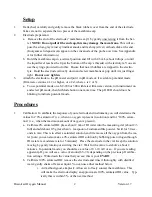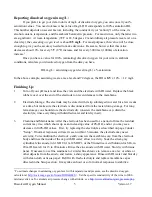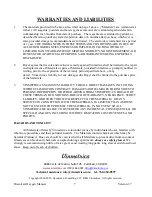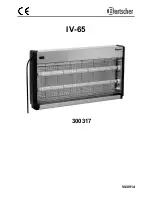
Dissolved Oxygen Manual
1 Version 1.7
Vinmetrica Dissolved Oxygen System
User Manual
The Vinmetrica Dissolved Oxygen system provides a simple, accurate and affordable way to determine
oxygen concentrations in wine and other samples.
Materials provided in the kit:
1.
Electrolyte Solution (PN: SC-200-13-2)
2.
Sodium sulfite powder (PN: SC-200-13-1)
(for 0% Oxygen reference)
3.
Vinmetrica Dissolved Oxygen (DO) probe
4.
Standard measuring vial
5.
One 5 mL syringe (SC-100-6)
6.
Extra DO probe membrane cap (SC-200-13-3)
Things you will need:
1.
Vinmetrica SC-200 or SC-300, or comparable meter with 1 mV or 0.02 pH resolution.
2.
Distilled water (DI water)
3.
Rinse bottle (PN: SC-100-17)
4.
Small measuring spoon or spatula (e.g., Vinmetrica 0.05 g spoon, PN: RS-12)
Why Test for Dissolved Oxygen?
Dissolved oxygen (DO) has numerous effects on wine, some desirable, some definitely not.
Depending on the type of wine and its characteristics, controlled exposure to oxygen plays a beneficial
role in wine quality such as influencing color stability and suppleness. However, too much oxygen
exposure can lead to premature deterioration, browning, and acetaldehyde formation. At time of
bottling, for example, it is generally desirable to keep DO below 10% saturation. DO can then be
measured throughout the bottling process to ensure oxygen uptake is minimized. Careful management
of DO will ensure best stability and outcome for your wine.
How it works:
The electrode has an internal electrolyte solution behind a gas-permeable membrane. Oxygen in
the sample diffuses into this internal electrolyte and creates an electrochemical (“galvanic”) reaction at
the metal contact on the electrode. This is picked up by the SC-200 or -300 and displayed as a voltage
reading (firmware x.1.2 or higher), or as an apparent “pH” value, either of which can be related to the
response of known oxygen content, allowing you to determine DO as % saturation.
Figure 1.
The Dissolved Oxygen Kit

























